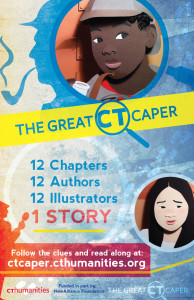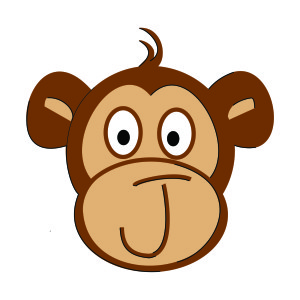Chapter 7 of The Great Connecticut Caper is here! We’re past the halfway mark and the story really took an interesting turn at the end of the previous chapter. It’s so hard waiting two weeks to see what happens next. J Monkeys, the author of chapter 7, stops by today to share a little about what it was like creating it. Welcome!
 What was your approach to writing chapter 7 of the Great CT Caper? Did it differ any from your approach when creating a piece written solely by you?
What was your approach to writing chapter 7 of the Great CT Caper? Did it differ any from your approach when creating a piece written solely by you?
It wasn’t much of a deviation for me; I’m a huge planner. I can’t “pants” my way through the day, let alone through a story. The biggest difference was the scale. I’ve written short stories before, but I was able to plan the whole thing, beginning, middle and end. That wasn’t the case for the Great CT Caper. So, I read the previous six chapters, thought about where we were in terms of the overall story then sketched a high level outline of what I wanted to do. I assigned a word count “budget” for each section, which I completely blew past. I’m a novelist by nature, so sticking to 650 words was really, very, impossibly hard for me.
What were your expectations coming into writing a collaborative, serialized story for young readers? Had you written anything like this before?
I’ve done collaborative writing before, with kids, but we do it together. This was very different because they didn’t want us to taint the creative process by hatching a plan from the start. We each just had to react to the stuff that came before us and go forward. It was neat.
Did you come across any particular challenges in writing your chapter?
Did I ever! The word count was rough. I decided to write out my chapter, then go back and edit it down to the appropriate size. Unfortunately, the first draft of chapter seven was 1400 words long, more than double what I was supposed to turn in. I edited it down to 700ish, but realized that I was breaking the most important rule of writing: “Show, don’t tell.” I was telling all over the place! The idea behind “show, don’t tell” is to allow the reader to experience the story with the characters instead of just telling them what happened. It takes a lot more words to “show” a conversation happening through dialogue, for example, than it does to “tell” a recap.
Did you do any research for the project?
Yup. Since my part was the middle of the story, I wanted to include some backstory on our villain. Who was Lady Hallow, why was she doing this and how? So I wanted to tie William Gillette back to Scotland and to the settling of Connecticut. I read up on Thomas Hooker, the Fundamental Orders, the Connecticut Charter and the history of the Charter Oak. I wanted to tie it all together more tightly than I did, but that durned word count got me again.
The Great CT Caper’s target audience is children in grades four through seven. What were some of your favorite books when you were that age?
Nancy Drew, for sure. I LOVED the Nancy Drew mysteries. I still have them on my shelf. I devoured the CS Lewis stories about Narnia, too. Little Women was a favorite of mine. Plus, I was a pretty advanced reader with a fairly permissive Mom. By the time seventh grade came along, I was reading adult historical romances. Certainly that wouldn’t be every parent’s decision, but I loved them. The stories, the swashbuckly-ness, the history. I still do love them.
What writers do you find inspire your own work?
I love adventure stories. Rick Riordan’s Percy Jackson stories, JK Rowling’s Harry Potter books, Suzanne Collins’ Gregor stories, The 39 Clues and The Infinity Ring series are all books that I go back to again and again. And CS Lewis’ world building was amazing.
If you were stranded on a desert island and could only bring two books and one movie, what would you bring?
Well, for books, I’d bring two humongous blank books with pencils smuggled inside them to write my own stories. And for a movie? Hmmmm. Tough call. I love history, so something really, really long, with lots of history to inspire ideas for my stories.
 Where else can readers find your writings? What’s up next for your writing career?
Where else can readers find your writings? What’s up next for your writing career?
All of my books are available on Amazon, and my website, of course. I expect to start book three of the Livingston-Wexford Adventures early this summer. I left my characters, 15-year olds Kayla and Quinn, in a bit of a tangle at the end of The Peacock Tale, so it’s time to move that story forward. And I wrote a tragedy as part of the “research” on my fictional pirate, Captain Peacock. I’m planning to revise that and release it as a companion piece. It’s really more of a Young Adult story than it is a Middle Grade adventure.
And I’m super excited about some work I’ve been doing this year. I’ve been working with kids, guiding them through a real-life writing adventure. We create, write, illustrate and edit a book, then publish it through Amazon. I’ve been working with schools and after-school programs, kids from Kindergarten through Fifth Grade. It’s been really fun and rewarding. When I get a minute, I need to update my website (www.jmonkeys.com) with links to their books. I’m starting to book programs for the 2015-16 school year now. There’s a link on my website, if anybody’s interested.
And finally, what is something funny/weird/exceptional about yourself that you don’t normally share with others in an interview?
Something funny. Hmmm. Well, it’s not so much funny “ha-ha” as it is funny “odd.” I have a pretty great vocabulary, but I’m a terrible speller. I mean awful. Like, spell-check can’t figure out what I’m trying to spell. Sometimes I don’t even know where to look in the dictionary to figure it out. And my handwriting is worse than my spelling. I sometimes take a break from the computer and go write by hand somewhere away from my house. Usually, when I get back and type it into the story document, there are at least two words that I can’t figure out, either because I butchered the spelling so badly or they’re simply illegible.
 Visit J Monkeys here:
Visit J Monkeys here:



















